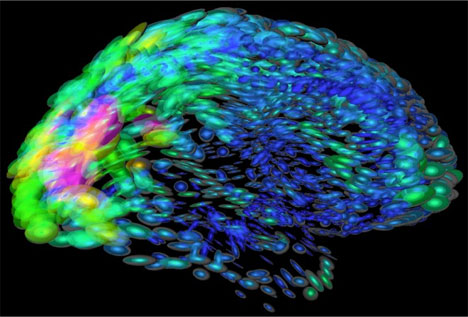The Triune Brain
God loves fractals. He (Father) speaks (Spirit) the Word (Son) and everything He creates is made in the image of the Triune, three distinct, yet indivisible, named parts working as one.
The Holy of Holies is triune. The Name (Word) dwells invisibly above the blood (Sacrament) on the kapporet (Government). Then, of course, we have the Most Holy, the Holy, and the Laver (the Laver is a beaten out “firmament” like the kapporet). Moving out again, and we have the Tent as Garden, the Tabernacle enclosure as Land, and outside the enclosure as World. Again, and we have the Tabernacle itself as Garden, Israel as Land, and Gentile “Sea” as World. Out again and we have Heaven (the true mountain of God) as Garden, the physical Land as, well, Land, and the physical sea as the Laver.
The human body is the same. Your head is Word, your body is Sacrament, and what you do with your limbs is Government. Within this, your head has a three-decker structure, with your brain “behind the Veil” flanked by two witnesses, ears as Servanthood and Dominion, nose for Incense, and mouth as Government (a court governed by your angelic teeth!). Apparently, within even this architecture, your brain has a three-decker structure. Edwin Friedman writes:
In 1990 Dr. Paul McLean, who had studied the human brain for more than thirty years at the National Institutes of Health, published a monumental volume entitled The Triune Brain. His thesis is that the human brain has three distinct parts, each of which developed at a different stage of evolution but evolved in an interconnected fashion, with information flowing reciprocally in both directions between all three parts. The brain, in other words, is itself a history, if not a manifestation, of the evolution of our species.
Other organs such as the kidneys, the lungs, the pancreas, or the bladder seem to have ceased evolving after reaching a form that fit their function. The brain, on the other hand, keeps changing its size and shape as animal life has evolved, so that the brain appears to be a hodgepodge. It is as though the Creator or Evolution had after-thoughts. The human brain has brown in weight from the few ounces found in reptiles to the “enormous” full pound found in early humans to its present “whopping” size of three pounds. But Dr. McLean has shown that the earliest brains have not been replaced by newer models. Rather, they remain as the substructure onto which new forms have been built, and into which new forms have been plugged. In fact, the older brain forms that still reside beneath, or at the base of, the modern human brain are structurally and chemically identical to their forerunners in reptiles and mammals.
At the base of the human brain, says McLean, is a bundle of nerve connections that is totally absent of thought processes. Its bailiwick is instinct. He has dubbed this the “reptilian brain.” Above that is the part of the brain that fills most of the cranium. It allows for thinking on rudimentary levels and evolved with early mammals. he has called this the “mammalian brain.” It is in the mammalian part of the brain that we find the apparatus for creating lasting relationships and therefore families. For it is in the mammalian brain that we first find the seat for nurturing, for playfulness, and for vocal communication.
The third part of the brain is the cortex, the half-inch layer at the top that most people think of as the “real” brain, and its frontal lobe, known as the neo-cortex. It is the cortex that is the center of intellectual activity, and it is the neo-cortex that allows for philosophical speculation, deep problem-solving, intricate strategies, leaders, healers, and, eventually, leadership training programs. But, as mentioned, even the cortex is not really a “central processing unit.” For the most part, the cortex functions interdependently with its reptilian and mammalian precursors. This is as true in gathering data as in making decisions. The information each part processes is to some extent modified by the information simultaneously processed by the other two parts. [1]
Well, of course I don’t go for the assertion that the brain evolved from these lower levels. The brain is no more a hodgepodge than the Tabernacle was, or the world is. The human brain is an ark. It has a place for the mediators in the Garden, the beasts in the Land, and the creeping things down below. And all parts are required to work in harmony for a fully functioning being made in the image of God. Like the Trinity, the brain is an indivisible three in one.
_________________________________
[1] Edwin H. Friedman, A Failure of Nerve: Leadership in the Age of the Quick Fix, pp. 119-120.



























July 17th, 2011 at 2:31 am
As a Christian chiropractor I’ve always mixed my metaphors when looking at the central nervous system.
I’ve always looked at the brain as God the Father (where ‘all’ the glory is), the spinal cord as Jesus (the mediator between the brain and the body), and the holy spirit as the ongoing messages back and forth between the brain and spinal cord and brain and body. I guess to stretch the metaphor, the peripheral nervous system (any nerves exiting the bony spinal column) is the church, and the rest of the body is the world.
July 17th, 2011 at 9:48 am
Dave
Good thoughts. I have some comments on that and will post them soon.
Kind regards,
Mike